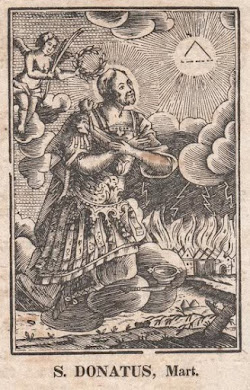Feast Day: 7 August; 30 June
Saint Donatus of Münstereifel, also known as Donatus of Evorea, was a Christian martyr who lived during the Roman persecution of Christians in the 4th century. Here is an overview of his life:
Early Life and Conversion Saint Donatus was born in Evorea, a region in present-day Turkey, during the late 3rd century. He came from a Christian family and grew up practicing his faith amidst the persecution of Christians under the Roman Emperor Diocletian.
Missionary Journey Donatus felt called to spread the Gospel and embarked on a missionary journey across Asia Minor (modern-day Turkey), preaching the Christian faith and baptizing new converts despite the risks involved during the period of intense persecution.
Capture and Martyrdom During his missionary work, Saint Donatus was captured by Roman authorities who sought to suppress Christianity. He was brought before the Roman governor and subjected to interrogation and torture. Despite the severe suffering inflicted upon him, Donatus refused to renounce his Christian faith.
Execution Saint Donatus was eventually sentenced to death for his refusal to worship Roman gods and his steadfast commitment to Christ. He was martyred by beheading, thus joining the ranks of countless Christians who gave their lives for their faith during the early centuries of Christianity.
Veneration After his death, Saint Donatus was venerated as a martyr for the faith. His relics were honored and enshrined in various churches, including the Abbey of Münstereifel in Germany, where he is particularly venerated. He became known as the patron saint of Münstereifel and his feast day is celebrated on July 7th.
Legacy Saint Donatus of Münstereifel is remembered for his courage in professing and spreading the Christian faith amidst persecution. His life and martyrdom continue to inspire Christians to remain steadfast in their beliefs and to bear witness to Christ, even in the face of adversity.
Donatus was buried by his mother in the Saint Agnes catacomb outside Rome. His relics remained hidden for centuries until they were rediscovered in 1646 by the Jesuit Balthasar Ballonus. These relics were later transferred to the Jesuit College church in Bad Münstereifel, Germany, in 1649.
The enshrinement of Saint Donatus' relics in the church of Saint Martin in Bad Münstereifel was accompanied by miraculous events. On 30 June 1652, during the procession to enshrine the relics, a pouring rain ceased as soon as the procession began. At the end of the Mass, lightning struck the church, causing lamps and candles to fall and setting the priest's vestments on fire. The priest called out for Saint Donatus to intercede, and the fire was immediately extinguished, leaving the priest unharmed.
Distribution of Relics
Relics of Saint Donatus are venerated in various locations across Europe:
- Church of Saint Michael in Weywertz, Belgium
- Abbey church in Neumünster, Luxembourg
- Church of Saint Anthony of Padua in Loosbroek, Netherlands
- Church of Saint Anthony the Abbot and Saint Donatus in Reek, Netherlands
- Church of Saint Anthony of Padua in Vragender, Netherlands
- Church of Saint Severinus in Hapert, Netherlands
Saint Donatus is invoked for protection against natural disasters and is considered the patron saint of:
Against lightning | Against storms | Against fire | Bakers | Wine makers | Buda, Hungary | Saint Donatus, Iowa (named in his honor by Luxembourgish immigrants)
Saint Donatus is often depicted as:
A soldier with a knife and palm branch | A soldier holding lightning bolts | A soldier near a burning church, often depicted alongside Saint Florian of Lorch
Saint Donatus' story exemplifies the Christian virtue of martyrdom and serves as a reminder of the sacrifices made by early Christians to uphold their faith in Christ. His feast day is an occasion for prayerful remembrance and gratitude for his witness to the Gospel.
.









%20Virgin%20and%20Martyr.jpeg)
No comments:
Post a Comment